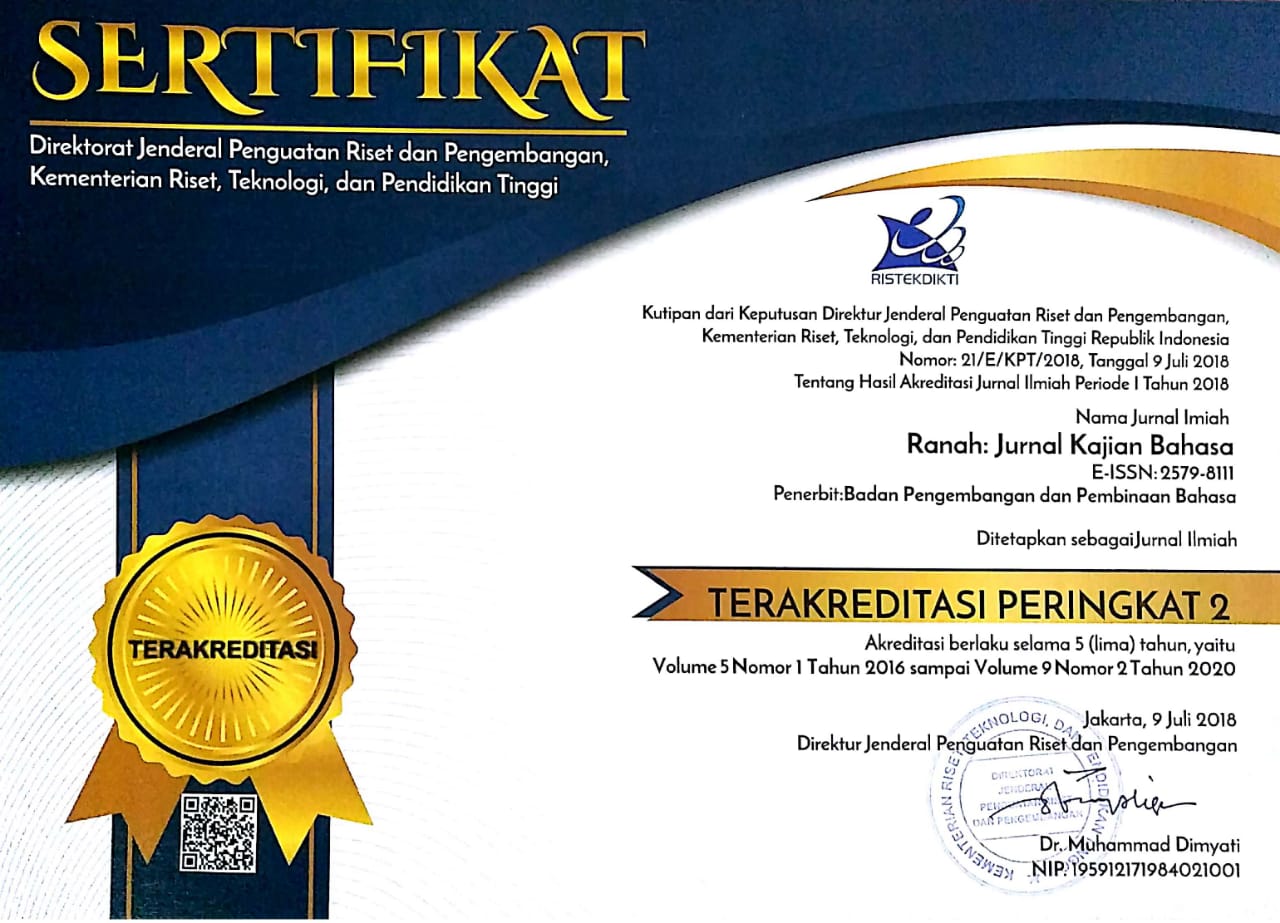Kajian Linguistik Kognitif Pada Imbuhan Ber- dalam Bahasa Indonesia
Abstract
Academic discourse on beR- affixes in Indonesian has been widely studied and analyzed. Generally, the studies only focus on three main valences: form, structure, and meaning. In its development, cognitive linguistics can be another alternative to examine beR- affixes in Indonesian by looking at the symptoms of expanding their meaning. By basing on the theory of categorization of prototype meanings and expansion meanings, cognitive linguistics is felt to be able to answer problems that often arise in the realm of beR- meaning meanings that tend to overlap. The results of this study suggest that cognitive linguistics can be an alternative study to fill the gaps in the study of beR- affixes in Indonesian. From the perspective of cognitive linguistics, the meanings present in the beR affix can be said to have expansion symptoms. The categorization analysis can see this of the meaning of the prototype and the meaning of its expansion. The prototype meaning of ¬beR- is mainly "doing something" with five types: holding something, acquiring something, and untransitive, reflexive, and reciprocal deeds. The meaning of the expansion is only identified four types: owning, wearing, state, and number.
Abstrak
Wacana akademik tentang imbuhan beR- dalam bahasa Indonesia sejatinya telah banyak dikaji dan dianalisis. Umumnya, kajian yang dilakukan hanya berkutat pada tiga valensi utama, yakni bentuk, struktur, dan makna. Pada perkembangannya, linguistik kognitif bisa menjadi alternatif lain untuk mengkaji imbuhan beR- dalam bahasa Indonesia dengan melihat gejala perluasan maknanya. Linguistik kognitif dengan mendasarkan pada teori kategorisasi makna prototipe dan makna perluasan dirasa mampu menjawab persoalan yang kerap muncul pada ranah makna imbuhan beR- yang cenderung tumpang-tindih. Hasil kajian ini menunjukkan bahwa linguistik kognitif bisa menjadi alternatif kajian untuk mengisi rumpang kekosongan pada kajian imbuhan beR- dalam bahasa Indonesia. Ditilik dari perspektif linguistik kognitif, makna-makna yang ada pada imbuhan beR- bisa dikatakan mengalami gejala perluasan. Hal ini bisa telihat dengan adanya analisis kategoriasi pada makna prototipe dan makna perluasannya. Makna prototipe imbuhan beR- berdomain utama “melakukan sesuatu” dengan lima jenis, yakni mengadakan sesuatu, memperoleh sesuatu, perbuatan taktransitif, refleksif, dan resiprok. Adapun makna perluasannya hanya teridentifikasi empat jenis, yakni memiliki, memakai, keadaan, dan jumlah.
Keywords
Full Text:
PDF (Bahasa Indonesia)References
Al-Qunayeer, H. S., Al-Ahdal, A., & Shawosh, A. E. S. (2020). Ferdinand de Saussure's Langue/Parole Binary in the Quran. International Journal of Innovation, Creativity and Change, 12(2), 406-417. https://ssrn.com/abstract=3570617
Almurashi, W. A. (2016). An Introduction to Halliday's Systemic Functional Linguistics. Journal for the Study of English Linguistics, 4(1), 70-80. https://doi.org/10.5296/jsel.v4i1.9423
Alwi, H., Dardjowidjojo, S., Lapoliwa, H., & Moeliono, A. M. (2010). Tata Bahasa Baku Bahasa Indonesia. Balai Pustaka.
Aryadoust, V. (2019). An Integrated Cognitive Theory of Comprehension. International Journal of Listening, 33(2), 71-100. https://doi.org/10.1080/10904018.2017.1397519
Bader, Y. F. & Obeidat, H. H. (2020). The Language of Facebook Comments on Political Articles in Jordan. International Journal of Linguistics, 12(6), 180-205. https://doi.org/10.5296/ijl.v12i6.18113
Beck, A. T. (2019). A 60-Year Evolution of Cognitive Theory and Therapy. Perspectives on Psychological Science, 14(1), 16-20. https://doi.org/10.1177/1745691618804187
Boldyrev, N. N. & Dubrovskaya, O. G. (2016). Sociocultural Commitment of Cognitive Linguistics Via Dimensions of Context. Ilha Do Desterro, 69(1), 173-182. https://doi.org/10.5007/2175-8026.2016v69n1p173
Djajasudarma, F. (2010). Metode Linguistik: Ancangan Metode Penelitian dan Kajian. Rafika Aditama.
Guo, J. (2020). Application of Embodied-Cognitive Linguistics in College English Reading Teaching. 2nd International Education Technology and Research Conference (IETRC 2020), 100-103. https://doi.org/10.25236/ietrc.2020.022
Gustiani, E. I. & Fujiastuti, A. (2022). Afiksasi Pada Rubrik Tajuk Rencana Surat Kabar Kedaulatan Rakyat. Kode : Jurnal Bahasa, 11(1). https://doi.org/10.24114/kjb.v11i1.335055
Jumari, N. A. & Haron, M. (2018). Pengajaran dan Pembelajaran Imbuhan Melalui Pendekatan Pembelajaran Aktif. Seminar Bahasa Melayu 2018, 19, 235-247.
Keraf, G. (1991). Tata Bahasa Rujukan Bahasa Indonesia. Gramedia.
Kiseleva, S. & Trofimova, N. (2017). Metaphor as a Device for Understanding Cognitive Concepts. Revista de Lenguas Para Fines Específicos, 23(2), 226-246. https://doi.org/10.20420/rlfe.2017.344
Lakoff, G. (2016). Language and Emotion. Emotion Review, 8(3), 269-273. https://doi.org/10.1177/-1754073915595097
Lindes, P., & Laird, J. E. (2016). Toward Integrating Cognitive Linguistics and Cognitive Language Processing. Proceedings of the 14th International Conference on Cognitive Modeling, 86-92.
Maizar, A. A. & Saihoob, A. A. A. (2021). Linguistic Developments from The Perspective of The Modern Linguistic Lesson. Ilkogretim Online, 20(3), 1320-1326. https://doi.org/10.17051/ilkonline.2021.03.148
Monbec, L. (2020). Systemic Functional Linguistics for the EGAP Module: Revisiting the Common Core. Journal of English for Academic Purposes, 43, 100794. https://doi.org/10.1016/j.jeap.2019.100794
Mustafa, I. & Purwasandy, T. K. (2020). Kata Kerja Transitif dan Intransitif dalam Bahasa Arab dan Bahasa Indonesia (Studi Linguistik Kontrastif). Studi Arab, 11(1), 1-12. https://doi.org/10.35891/sa.v11i1.1891
Musyayyab, I. & Arimi, S. (2020). Perspektif dan Frame Ekspresi Permintaan Maaf dalam Diskusi Indonesian Lawyers Club "50 Tahun G30S/PKI, Perlukah Negara Minta Maaf?": Kajian Linguistik Kognitif. Jurnal Bastrindo Kajian Pendidikan Bahasa dan Sastra Indonesia, 1(2), 124-139. https://doi.org/10.29303/jb.v1i2.48
Paknezhad, M. & Naghizadeh, M. (2016). The Analysis of the Image Schemata in Persian and Arabic Proverbs with a Cognitive Semantics Approach. Journal of Applied Linguistics and Language Research, 3(2), 272-283.
Pankratova, S. A. (2017). Metaphoric Mechanism in Image Scheme Development. Russian Linguistic Bulletin, 2(10), 62-64. https://doi.org/10.18454/RULB.10.02
Prihantini, A. (2015). Master Bahasa Indonesia: Panduan Tata Bahasa Indonesia Terlengkap. Bentang B first.
Rangriz, S. & Harati, M. (2017). The Relationship between Language and Culture. Journal of Applied Linguistics and Language Research, 4(6), 209-213.
Reda, G. (2016). Ferdinand De Saussure in the Era of Cognitive Linguistics. Language and Semiotic Studies, 2(2), 89-100. https://ssrn.com/abstract=3060201
Ruzibaeva, N. R. (2021). Cognitive Linguistics: Basic Concepts. Academic Research in Educational Science, 2(1), 438-446.
Saifudin, A. (2018). Konseptualisasi Citra Hara "Perut" dalam Idiom Bahasa Jepang. Japanese Research on Linguistics, Literature, and Culture, 1(1), 65-78. https://doi.org/10.33633/jr.v1i1.2130
Sajjad, F., Malghnai, M. & Khosa, D. (2018). Language, Social Media and Political Identity (Re)presentation: A New Theoretical Framework for the Analysis of Social Media Political Discourse. International Journal of English Linguistics, 8(2), 199-206. https://doi.org/10.5539/ijel.v8n2p199
Schunk, D. H., & DiBenedetto, M. K. (2020). Motivation and Social Cognitive Theory. Contemporary Educational Psychology, 60, 101832. https://doi.org/10.1016/j.cedpsych.2019.101832
Sitorus, J. P. (2019). Mengenal Tata Bahasa Indonesia. Evernity Fisher Media.
Sudaryanto. (2015). Metode dan Aneka Teknik Analisis Bahasa. Sanata Dharma University Press.
Thompson, G., Bowcher, W. L., Fontaine, L., & Schönthal, D. (2019). The Cambridge Handbook of Systemic Functional Linguistics. Cambridge University Press. https://doi.org/10.1017/9781316337936
Tuggy, D. (2009). The affix-stem distinction: A Cognitive Grammar analysis of data from Orizaba Nahuatl. Cognitive Linguistics, 3(3), 237-300. https://doi.org/10.1515/cogl.1992.3.3.237
Umiyati, A., Surya Pratama, B., Aini, N. & Ayu Kesumastuti, W. (2021). Afiks Derivasional Ber- pada Media Massa Indonesia. Hasta Wiyata, 4(2), 81-105. https://doi.org/10.21776/ub.hastawiyata.2021.004.02.01
Umman, K. Z. Al. (2015). Ferdinand de Saussure: Structuralism and His Role in Modern Linguistics. Lisanudhad, 2(1), 1-19. https://doi.org/10.21111/lisanudhad.v2i1.469
Verspoor, M. H. (2017). Cognitive Linguistics and Its Applications to Second Language Teaching BT - Language Awareness and Multilingualism (J. Cenoz, D. Gorter, & S. May (eds.); pp. 55-66). Springer International Publishing. https://doi.org/10.1007/978-3-319-02240-6_4
Xiao, R. (2017). Combining Transformative Generative Grammar and Systemic Functional Grammar: Linguistic Competence, Syntax and Second Language Acquisition. International Journal of English and Literature, 8(4), 37-42. https://doi.org/10.5897/IJEL2017.1050
DOI: https://doi.org/10.26499/rnh.v11i2.3937
Refbacks
- There are currently no refbacks.








